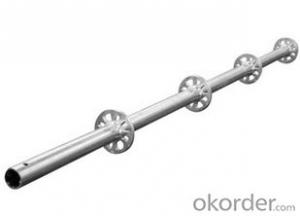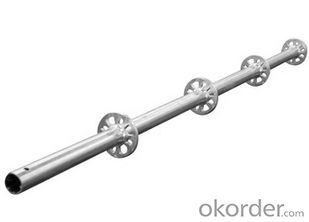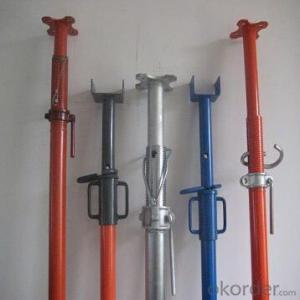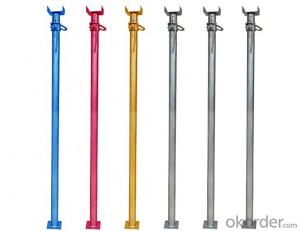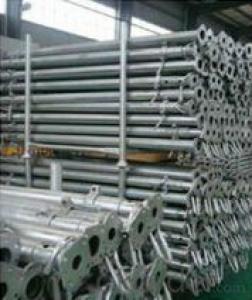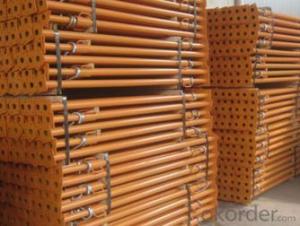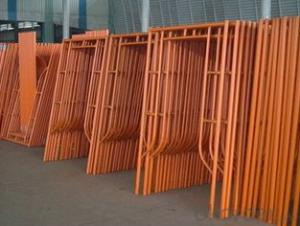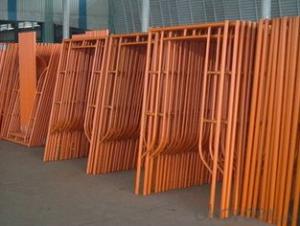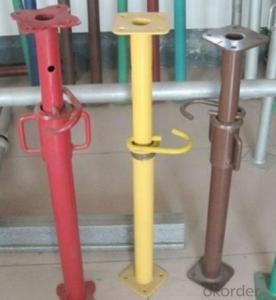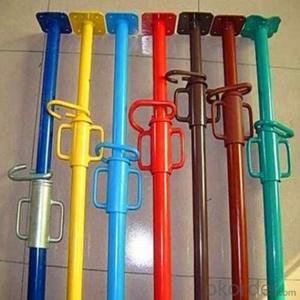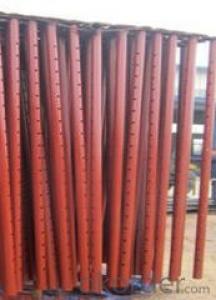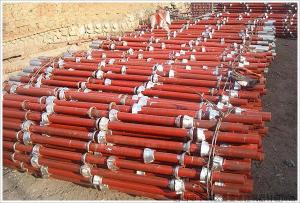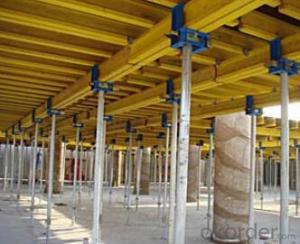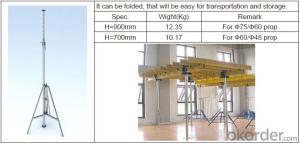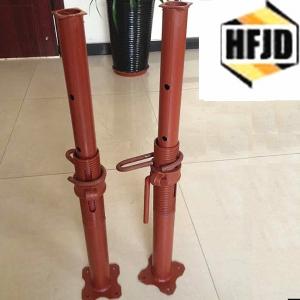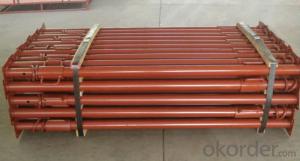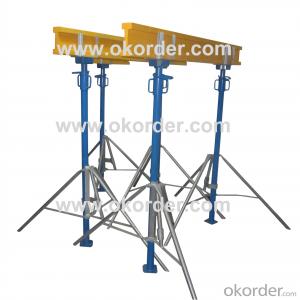Adjustable Steel Props, Steel Tubular Scaffold
- Loading Port:
- Tianjin
- Payment Terms:
- TT OR LC
- Min Order Qty:
- 10000 PCS
- Supply Capability:
- 10000 PCS/month
OKorder Service Pledge
OKorder Financial Service
You Might Also Like
Quick Details
| Model Number: | 6082 | ||||
| Material:: | Aluminium Alloy 6082-T6 | color:: | orange, blue, red, grey or gree | Certi:: | ISO,SGS BV CE |
| inspection:: | factory in-house, 3rd pary | delivery time:: | 7-30 days as per order quantity | Payment terms:: | L/C, T/T, D/P, D/A, etc |
| No welding scaffolding:: | Weld free tubular design | Featrues:: | flexible,High stiffness and resi | Business type:: | manufacturer |
Packaging & Delivery
| Packaging Detail: | solid iron case or anti-suffocating wooden case |
| Delivery Detail: | within 30 days after upon order and deposit |
Specifications
1.competitive price
2.Best quality
3.Fast delivery
4.Factory offer
5.Free sample
Specifications
Gate Scaffolding for Construction
High quality, most competitive price
Safe & durable
Large sales quantity
ISO9001
Product Description
MODEL D
Size: 914*1700*1800mm (Width*Height*Length)
Total weight:26.40kg/38.40kg (with walk board)
Surface: galvanised/painting
MODEL DB
Size:1219*1700*1800(Width*Height*Length)
Total weight: 28.80kg/40.80kg (with walk board)
Surface: galvanised/painting
MODEL E
Size: 914*1700*1800mm (Width*Height*Length)
Total weight:26.40kg/38.40kg (with walk board)
Surface: galvanised/painting
MODEL EB
Size:1219*1700*1800(Width*Height*Length)
Total weight: 28.80kg/40.80kg (with walk board)
Surface: galvanised/painting
MODEL EH
Size:1219*1930*1800(Width*Height*Length)
Total weight: 30.20kg/42.20kg (with walk board)
Surface: galvanised/painting
MODEL F
Size:1500*1500*1800(Width*Height*Length)
total weight: 35.00kg/47.00kg (with walk board)
Surface: galvanised/painting
Features:
1) All tubes of verticals and horizontals are high strength grade at 48.3 x 3.25mm, Q345 tube
2) The ring plates(Rosettle) are all made by 10mm thickness high Tensional plate,Q345
3) All tubes of braces are high strength grade at 48.3 x 2.3mm
4) The bolts on braces are high strength grade
5) All items are at hot-dipped-galvanized finishing, unless specified
6) Can also be manufactured as per customers' requirements
7) Export Packing : Iron Pallet
- Q: Can a steel prop be used to support a suspended ceiling?
- Yes, a steel prop can be used to support a suspended ceiling.
- Q: Are steel props adjustable in small increments for precise leveling?
- Yes, steel props are adjustable in small increments for precise leveling. Steel props, also known as adjustable steel props or scaffolding props, are commonly used in construction projects to provide temporary support and stability to beams, walls, and ceilings. These props consist of two main components - an outer tube and an inner tube. The inner tube can be adjusted to various heights, allowing for precise leveling of the supported structure. The adjustment is typically done by rotating a threaded collar on the outer tube, which causes the inner tube to move up or down in small increments. This adjustability feature makes steel props an excellent choice for achieving precise and accurate leveling in construction projects.
- Q: Are steel props adjustable?
- Yes, steel props are adjustable. Steel props, also known as adjustable steel props or steel acrow props, are commonly used in construction and temporary support applications. They are designed to provide temporary support to beams, walls, or ceilings during construction or renovation projects. Steel props are usually made up of two main components: an outer tube and an inner tube. The outer tube is typically made of high-quality steel and has several holes along its length, while the inner tube can slide inside the outer tube and is used to adjust the height of the prop. To adjust the prop, you simply need to unlock the prop's collar and slide the inner tube up or down to the desired height. Once you've set the desired height, you lock the collar again to secure the prop in place. This adjustability feature allows steel props to be easily adjusted to different heights, making them versatile and flexible for various construction needs. Steel props are known for their strength, stability, and load-bearing capacity. They are commonly used in applications such as supporting formwork, scaffolding, or temporary structures. The adjustable nature of steel props allows for easy installation and removal, as well as the ability to adapt to different project requirements. Overall, steel props are a reliable and adjustable solution for temporary support needs in construction projects, providing stability and safety during the construction process.
- Q: Are steel props subject to any industry standards or regulations?
- Yes, steel props used in construction are subject to industry standards and regulations. These standards ensure that the props meet specific safety requirements and performance criteria, ensuring the structural integrity and stability of temporary support systems in various building projects. Compliance with these standards is crucial to ensure the safety of workers and the successful completion of construction projects.
- Q: What are the common sizes and lengths available for steel props?
- The sizes and lengths of steel props available vary depending on the manufacturer and region. However, there are standard dimensions widely found in the market. Steel props, also called adjustable scaffolding props, are commonly used in construction and formwork applications to provide support during the construction process. Regarding sizes, steel props typically come in different diameters, ranging from 40mm to 60mm. The most commonly used diameter is 48mm, which offers a good balance between strength and weight, making it suitable for most construction projects. In terms of lengths, steel props are available in adjustable ranges. The lengths can vary from 1 meter to 5 meters or more. The most frequently used lengths are 2 meters, 3 meters, and 4 meters, providing versatility and flexibility in supporting various heights and structures. It is important to note that some manufacturers may offer customized sizes and lengths based on specific project requirements. These customized options can meet unique construction needs, such as supporting heavier loads or accommodating irregular structures. When choosing steel props, it is crucial to consider the load-bearing capacity and the specific requirements of the project. It is advisable to consult construction professionals or suppliers to determine the appropriate size and length of steel props needed for a particular project.
- Q: Can steel props be used in both indoor and outdoor construction projects?
- Yes, steel props can be used in both indoor and outdoor construction projects. Steel props, also known as adjustable steel props or steel acrow props, are versatile and durable support structures used to provide temporary support to ceilings, walls, beams, and other structures during construction or renovation. One of the key advantages of steel props is their ability to withstand various weather conditions, making them suitable for both indoor and outdoor projects. Whether it is a construction site exposed to rain, snow, or extreme temperatures, or an indoor renovation project within a controlled environment, steel props can be relied upon to provide the necessary support. Moreover, steel props are adjustable in height and can be easily extended or retracted to accommodate different construction requirements. This flexibility allows them to be used in a wide range of indoor and outdoor applications, such as supporting formwork, scaffolding, or providing temporary support to damaged structures during repairs. Additionally, steel props are made from high-quality steel, ensuring their strength and stability. They are designed to bear heavy loads and provide reliable support, making them suitable for various construction projects, regardless of the location. In conclusion, steel props are a versatile and durable support system that can be used in both indoor and outdoor construction projects. Their ability to withstand different weather conditions, adjustable height, and strength make them an ideal choice for providing temporary support during construction or renovation works.
- Q: Are there any environmental considerations when using steel props?
- Yes, there are environmental considerations when using steel props. Steel production requires significant amounts of energy and resources, contributing to greenhouse gas emissions and environmental degradation. Additionally, the extraction and processing of steel raw materials can have negative impacts on ecosystems and local communities. Proper disposal or recycling of steel props at the end of their life cycle is also essential to minimize environmental harm.
- Q: How to distinguish between the columns of single and double steel support
- 1, the post section is consistent with the single column brace. The upper and lower sections of the column are not consistent, and the lower column is supported.
- Q: Can steel props be customized for specific projects?
- Yes, steel props can be customized for specific projects. Steel props are versatile and can be adjusted in height, width, and load-bearing capacity to meet the requirements of different construction projects. Customization allows for optimal support and stability, ensuring the safety and efficiency of the construction process.
- Q: What are the different types of steel props?
- Steel props, which are adjustable and temporary support structures, are commonly used in construction to provide support to ceilings, walls, beams, and other structural elements. The market offers various types of steel props, each designed for specific purposes and load-bearing capacities. 1. The most commonly used type of steel props is the adjustable steel props, which consist of an inner tube and an outer tube. The inner tube can be easily adjusted to the desired height using a threaded mechanism, allowing for convenient installation and adjustment. 2. Push-pull props, also known as shore props, are designed to provide support in both compression and tension. They consist of two steel tubes connected by a threaded rod. These props are frequently used in applications where temporary bracing is necessary. 3. Light duty props, on the other hand, are designed for lighter loads and are typically used in residential construction or smaller projects. They are lighter and easier to handle compared to heavy-duty props, making them suitable for less demanding applications. 4. Heavy-duty props, as their name suggests, are designed to support heavier loads. They are commonly used in commercial or industrial construction projects that require higher load-bearing capacities. These props are usually made from thicker steel tubes and have a larger diameter to provide increased strength and stability. 5. Acrow props are a specific type of adjustable steel props with a unique design. They consist of an outer tube, an inner tube, and a pin system that allows for quick and easy adjustment. Acrow props are commonly used in formwork and falsework applications. 6. Trench props, also known as struts, are specially designed to support trench walls during excavation or trenching work. They are adjustable in height and can be easily installed and removed as needed. 7. Formwork props are used to support formwork systems during concrete pouring. They are designed to withstand high vertical loads and provide stability to the formwork structure. In conclusion, the various types of steel props available include adjustable steel props, push-pull props, light duty props, heavy duty props, acrow props, trench props, and formwork props. Each type serves a specific purpose and has different load-bearing capacities, ensuring efficient and safe temporary support in construction projects.
Send your message to us
Adjustable Steel Props, Steel Tubular Scaffold
- Loading Port:
- Tianjin
- Payment Terms:
- TT OR LC
- Min Order Qty:
- 10000 PCS
- Supply Capability:
- 10000 PCS/month
OKorder Service Pledge
OKorder Financial Service
Similar products
Hot products
Hot Searches
Related keywords
